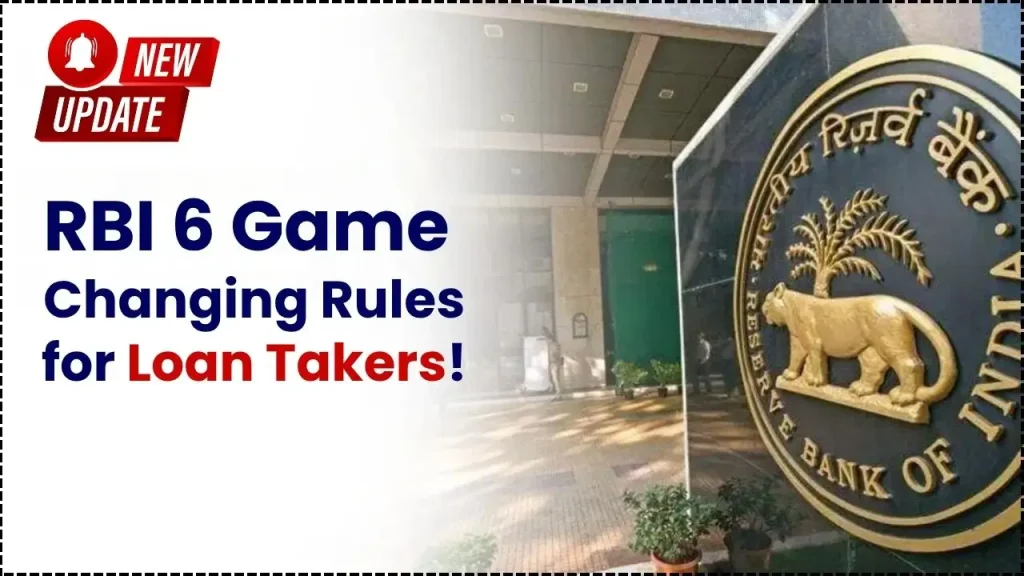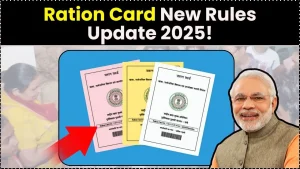If you’ve been waiting for a fair chance to lower your EMIs and fix credit report issues without running from pillar to post, this is that moment. The new RBI framework removes prepayment penalties on a wide swathe of floating-rate loans, compels lenders to clean up and update your credit data faster, and standardizes disclosures so you can switch or prepay without nasty surprises. In plain words: easier refinancing, cheaper loans over time, and a cleaner path to a higher credit score.

RBI loan rules 2025 are designed to put borrowers first: no prepayment or foreclosure charges on specified floating-rate loans, strong standards for how credit data is reported and corrected, and clear timelines so your responsible behavior translates into better pricing sooner. With these rules binding banks and NBFCs, borrowers finally get the freedom to move to better rates, part-prepay without penalties, and correct bureau errors quickly and transparently.
RBI Announces 6 Game-Changing Rules
| Rule/Change | What It Means | Impact On EMIs/Score | N/A |
|---|---|---|---|
| No prepayment/foreclosure charges on many floating-rate loans | Lenders cannot levy fees when you part-prepay or close eligible floating-rate loans | Enables free switching and principal reduction to cut EMIs or tenure | |
| Tier-wise coverage for business-purpose floating loans | Larger lenders barred from prepayment fees for individuals/MSEs; smaller lenders barred up to ₹50 lakh | Broadens refinancing freedom and competitive pricing pressure | |
| No retrospective or hidden charges | Previously waived charges can’t be re-applied; clear disclosure in sanction letter, agreement, and KFS | Predictable savings when switching or prepaying | |
| Standardized credit information reporting | Mandatory participation across bureaus, uniform formats, regular updates | Faster reflection of repayments, fewer data gaps, quicker score recovery | |
| Consumer access, alerts, and redressal | Structured mechanisms to access reports, dispute errors, and get reasoned outcomes | Quicker error fixes and fewer surprise score dips | |
| Clear timeline for prepayment rule | Prepayment Directions notified in 2025, effective for loans sanctioned/renewed on or after Jan 1, 2026 | Plan balance transfers and prepayments to maximize savings |
RBI loan rules 2025 finally remove the biggest friction for floating-rate borrowers prepayment penalties while forcing cleaner, faster credit reporting that lets your good behavior show up in your score without delay. Put simply, you now have the freedom and tools to refinance, part-prepay, and maintain a spotless credit file. Use them deliberately: run the numbers on a balance transfer, prioritize tenure cuts when prepaying, and audit every bureau quarterly. That’s how you translate regulatory relief into real EMI savings today and better credit opportunities tomorrow.
What Exactly Changed For Floating-Rate Loans
- Individuals (non-business purpose): Floating-rate loans to individuals (such as most home loans and personal loans when on floating rates) cannot attract prepayment or foreclosure charges. This applies even if there are co-borrowers, and whether you prepay partially or fully.
- Individuals and MSEs (business purpose): For business-purpose floating-rate loans given to individuals and micro/small enterprises, larger banks and specified NBFC categories cannot levy prepayment charges. Smaller institutions also cannot levy these charges up to a ₹50 lakh sanctioned limit, expanding the relief meaningfully for small-business borrowers.
- No lock-in, no source restriction: There’s no minimum lock-in period for prepayment relief, and lenders cannot discriminate based on the source of funds used for prepayment. If a charge was waived earlier, it cannot be resurrected at closure.
- Housing finance nuance: Housing finance companies already had specific protections on certain fixed-rate housing loans prepaid from own sources; the new regime reinforces uniform borrower-friendly conduct on floating-rate loans and closes loopholes that created switching friction.
Why This Lowers EMIs In Practice
- Balance transfers become frictionless: With penalties removed, you can shift to the best available rate without handing over savings in the form of exit fees. If competitors offer a lower spread or processing incentives, the math tilts in your favor.
- Part-prepayments work harder: Every rupee of a part-prepayment hits principal without being diluted by charges. Keeping the EMI constant and cutting tenure often maximizes lifetime interest savings, while opting to reduce EMI can deliver immediate monthly relief.
- Competitive pressure on pricing: When switching is easy, lenders must work to retain customers expect sharper repricing offers on existing loans and more aggressive onboarding rates for balance transfers. The net effect is lower borrower cost over time.
RBI Loan Rules 2025 And Your Credit Score
- Faster, complete reporting: Lenders must report to all recognized credit bureaus, using standardized formats and regular cycles. That means your on-time repayments, closures, and limit decreases reflect faster and more consistently across bureaus.
- Stronger correction pathways: Structured access and dispute mechanisms, along with reasoned resolutions, reduce the time bad data can depress your score. You get clearer visibility into who accessed your file and why, plus a documented trail if a correction is declined.
- Fewer mismatches across bureaus: Uniform participation and validation cut the odds that one bureau shows an overdue while another shows “closed.” Fewer mismatches translate into steadier scores and smoother loan pricing.
Action Plan To Capture The Benefits
- Rate-check your floating loans: Note your current effective rate and margin. Compare with live market offers for balance transfers on similar profiles. If the spread difference after fees is meaningful, initiate a switch after your loan qualifies under the new effective timeline.
- Use windfalls to shorten tenure: If cash flows are healthy, direct bonuses and surplus toward principal and instruct the lender to keep the EMI unchanged while cutting tenure. This approach often maximizes interest saved over the loan’s life.
- Audit all credit bureaus quarterly: Since lenders must report broadly, ensure your profile is accurate across bureaus. Fix discrepancies promptly; do not rely on a single bureau’s version when applying for credit.
- Preserve your paperwork: Keep your sanction letter, loan agreement, and Key Facts Statement. Clear disclosure rules help in case of disputes, especially around prepayment, closure, and any charges shown by mistake.
- Time your refinance: The prepayment rule applies to loans sanctioned or renewed from the effective date. If your loan will be renewed soon, plan to align that milestone with your switch or prepayment to fully leverage the new regime.
- Don’t ignore fees beyond penalties: While prepayment penalties are barred in many cases, assess processing charges, legal fees, MOD charges, and incidental costs. A fair balance transfer still needs net savings to be positive.
Who Gains the Most
- Home loan borrowers on floating rates: In a declining or competitive rate environment, the ability to switch without exit penalties pays off quickly, either via smaller EMIs or a much shorter tenure.
- First-time and young salaried borrowers: Clean, timely credit reporting helps responsible behavior show up in scores faster, leading to better approval odds and lower rates on new lines of credit.
- MSEs with floating working capital/term loans: Tier-wise relief on prepayment fees opens the door to better-priced credit, aiding cash flows and margins especially critical for smaller enterprises.
- Consolidators and upgraders: If you are rolling multiple loans into a single facility or upgrading a home with a top-up, penalty-free exits make restructuring more economical.
Key Timelines and Scope to Remember
- Prepayment charge regime: The ban on prepayment/foreclosure charges applies to eligible floating-rate loans sanctioned or renewed on or after the notified effective date. Existing loans continue under their current terms unless renewed thereafter.
- Regulated entities covered: Commercial banks (excluding payments banks), cooperative banks, NBFCs, and All India Financial Institutions fall under the directions, with specific tiering for business-purpose floating-rate loans to individuals and MSEs.
- Credit reporting directions: The credit information reporting framework is operative, mandating broader bureau membership, standardized formats, timely updates, and structured consumer redressal.
RBI loan rules 2025 reshape borrowing by eliminating prepayment penalties on many floating-rate loans and tightening credit reporting so your repayments and closures reflect faster in scores. This twin push freedom to refinance and faster, cleaner data puts pressure on lenders to offer better pricing and makes it easier for you to lower EMIs or shorten tenure without friction. With standardized disclosure, clear timelines, and broad coverage across banks and NBFCs, borrowers can plan balance transfers strategically, use part-prepayments more effectively, and keep credit files error-free. The result is practical savings today and stronger credit health for future borrowing.
FAQs on RBI Announces 6 Game-Changing Rules
Do These Rules Automatically Reduce My EMI?
No. The rules remove barriers. To actually lower EMIs, either refinance to a lower rate or use part-prepayments. You choose whether to reduce EMI or cut tenure; both save interest, but cutting tenure often saves more in the long run.
Are Fixed-Rate Loans Covered the Same Way?
The flagship relief targets floating-rate loans. Fixed-rate products can have prepayment terms per lender policy, and housing finance already had certain protections in defined scenarios. Always read your agreement and Key Facts Statement.
Will My Credit Score Improve Immediately Under The New Reporting Standard?
If you’re paying on time and closing accounts cleanly, updates should reflect more consistently and quickly. That means improvements can surface sooner, though exact score movement depends on your overall credit mix and utilization.
Is There Any Lock-In Before I Can Prepay Under The New Regime?
For the covered floating-rate loans, there’s no minimum lock-in for the prepayment relief, and lenders can’t penalize you based on the source of prepayment funds. Confirm your loan’s eligibility by date and category.
How Do I Know If Switching Is Worth It?
Calculate the all-in savings: compare the new rate versus your current rate, then subtract processing, legal, and incidental fees. If the breakeven arrives quickly and the remaining tenure is long, a switch often makes strong financial sense.
















